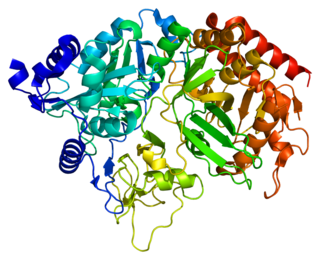Related Research Articles

Thyroxine 5-deiodinase also known as type III iodothyronine deiodinase (EC number 1.21.99.3) is an enzyme that in humans is encoded by the DIO3 gene. This enzyme catalyses the following chemical reaction

In molecular biology, SNORD115 is a non-coding RNA (ncRNA) molecule known as a small nucleolar RNA which usually functions in guiding the modification of other non-coding RNAs. This type of modifying RNA is usually located in the nucleolus of the eukaryotic cell which is a major site of snRNA biogenesis. HBII-52 refers to the human gene, whereas RBII-52 is used for the rat gene and MBII-52 is used for naming the mouse gene.

Calpain-10 is a protein that in humans is encoded by the CAPN10 gene.

HNF1 homeobox B, also known as HNF1B or transcription factor 2 (TCF2), is a human gene.

Wolframin is a protein that in humans is encoded by the WFS1 gene.

Small nuclear ribonucleoprotein-associated protein N is a protein that in humans is encoded by the SNRPN gene.

Zinc finger protein PLAGL1 is a protein that in humans is encoded by the PLAGL1 gene.

Mesoderm-specific transcript homolog protein is a protein that in humans is encoded by the MEST gene.

Phosphoenolpyruvate carboxykinase 1 (soluble), also known as PCK1, is an enzyme which in humans is encoded by the PCK1 gene.

Tetraspanin-7 is a protein that in humans is encoded by the TSPAN7 gene.

Receptor-type tyrosine-protein phosphatase N2 (R-PTP-N2) also known as islet cell autoantigen-related protein (ICAAR) and phogrin is an enzyme that in humans is encoded by the PTPRN2 gene. PTPRN and PTPRN2 are both found to be major autoantigens associated with insulin-dependent diabetes mellitus.

Forkhead box protein N3 is a protein that in humans is encoded by the FOXN3 gene.

Zinc finger protein 330 is a protein that in humans is encoded by the ZNF330 gene.

Transcription factor AP-2 beta also known as AP2-beta is a protein that in humans is encoded by the TFAP2B gene.

Transient neonatal diabetes mellitus (TNDM) is a form of neonatal diabetes presenting at birth that is not permanent. This disease is considered to be a type of maturity onset diabetes of the young (MODY).
Neonatal diabetes mellitus (NDM) is a disease that affects an infant and their body's ability to produce or use insulin. NDM is a monogenic form of diabetes that occurs in the first 6 months of life. Infants do not produce enough insulin, leading to an increase in glucose accumulation. It is a rare disease, occurring in only one in 100,000 to 500,000 live births. NDM can be mistaken for the much more common type 1 diabetes, but type 1 diabetes usually occurs later than the first 6 months of life. There are two types of NDM: permanent neonatal diabetes mellitus (PNDM), a lifelong condition, and transient neonatal diabetes mellitus (TNDM), a form of diabetes that disappears during the infant stage but may reappear later in life.

Zinc finger protein 57 homolog (ZFP57), also known as zinc finger protein 698 (ZNF698), is a protein that in humans is encoded by the ZFP57 gene.

In molecular biology, GNAS antisense RNA , also known as GNAS-AS1, is a long non-coding RNA.It is antisense to the GNAS gene. It is an imprinted gene, expressed only from the paternal allele, suggesting that it may have a role in suppression of the paternal NESP55 allele encoded by GNAS.
In molecular biology, MEST intronic transcript 1, antisense RNA, also known as MESTIT1 or PEG1-AS is a long non-coding RNA. It is an imprinted gene, which is paternally expressed. In humans, it is found on chromosome 7q32, imprinted genes on chromosome 7 are believed to be involved in Russell-Silver syndrome (RSS). However, it is believed that MESTIT1 is unlikely to cause Russell-Silver syndrome as there is a lack of mutations in this gene in Russell-Silver syndrome patients. MESTIT1 may regulate the expression of the MEST gene.

Neuronatin (Nnat) is a protein coding gene involved in mammalian brain development. It is located on Chromosome 20 in humans and is only expressed from the paternal allele in normal adults. It encodes the protein neuronatin, a proteolipid, that functions in the control of ion channels during brain development. Neuronatin begins the differentiation of pluripotent stem cells into cells with a neural fate by increasing their calcium levels. Neuronatin expression in neural tissues throughout the brain contributes to development of the nervous system. It is also expressed in several tissues outside of the brain. For example, expression in skin cells controls the differentiation of keratinocytes. Neuronatin expression functions not only in development, but other processes throughout the body. It also plays a direct and indirect role in diabetes. Increased expression in pancreatic islet beta cells causes the beta form of the protein to build an aggregate structure. This causes the cells to undergo apoptosis, thus leading to diabetes mellitus. Its effects on glycogen metabolism through the dephosphorylation and activation of the enzyme glycogen synthase may also play an indirect role in contributing to the disease. A different type of malformation in the gene also has the potential to cause a variety of cancers. Contained within the promoter region of the gene are three CpG islands. These imprint regions function in the regulation of gene expression through the process of cytosine methylation. The loss of methylation within these areas triggers an irregular cell growth, resulting in embryonic neoplasms.
References
- ↑ Arima T, Drewell RA, Oshimura M, Wake N, Surani MA (2000). "A novel imprinted gene, HYMAI, is located within an imprinted domain on human chromosome 6 containing ZAC". Genomics. 67 (3): 248–255. doi:10.1006/geno.2000.6266. PMID 10936046.
- ↑ Mackay DJ, Temple IK (2010). "Transient neonatal diabetes mellitus type 1". Am J Med Genet C Semin Med Genet. 154C (3): 335–342. doi:10.1002/ajmg.c.30272. PMID 20803656.